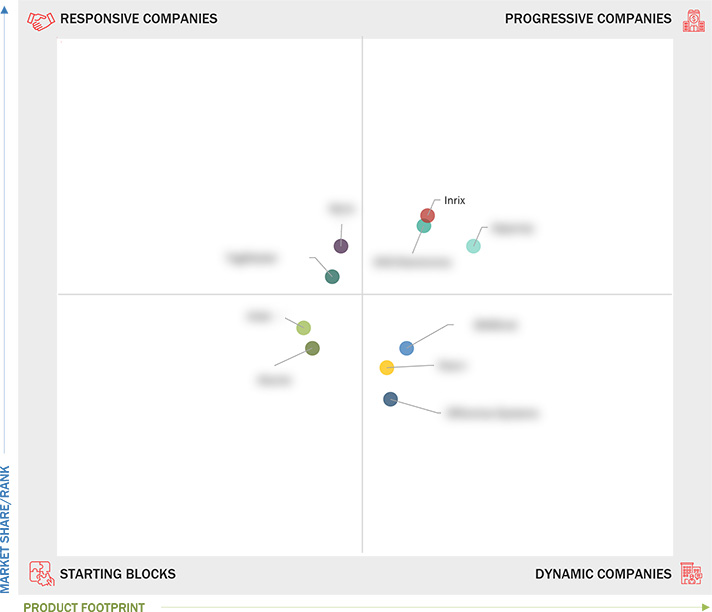Comparing 10 vendors in Smart Transportation Startups across 0 criteria.
The global smart transportation market is on a notable growth trajectory, predicted to surge from approximately USD 129.7 billion in 2024 to around USD 276.7 billion by 2029, at a significant compound annual growth rate (CAGR) of 16.4%. This expansion can be attributed to multiple factors, including advancements in technology, an increase in autonomous and connected vehicles, and rising government initiatives for public-private partnerships (PPP) in smart transportation.
Market Leadership Quadrant
1.1 Study Objectives
1.2 Market Definition
1.3 Study Scope
1.3.1 Market Segmentation
1.3.2 Inclusion and Exclusion
1.3.3 Years Considered
1.4 Currency Considered
1.5 Stakeholders
1.6 Summary of Changes
2.1 Introduction
2.2 Market Dynamics
2.2.1 Drivers
2.2.1.1 Increasing demand for autonomous and connected vehicles
2.2.1.2 Technological advancements to enhance customer experience
2.2.1.3 Growing government initiatives and PPP models for smart transportation
2.2.1.4 Rising urban population and high demographic rates
2.2.2 Restraints
2.2.2.1 Integration challenges for new age and legacy systems
2.2.2.2 Lack of standardized and uniform technology
2.2.2.3 Stringent transportation regulatory policies
2.2.3 Opportunities
2.2.3.1 Leveraging smart city initiatives for growth in smart transportation
2.2.3.2 Designing and developing connected vehicles compatible with ITS
2.2.3.3 Penetration of analytics in smart transportation
2.2.3.4 Decline in vehicle ownership with advancement of MaaS
2.2.4 Challenges
2.2.4.1 Scalability of smart transportation solutions in large cities
2.2.4.2 High initial cost of deployment
2.2.4.3 Multiple sensors and touchpoints posing data fusion challenges
2.3 Evolution of Smart Transportation
2.4 Ecosystem
2.5 Market Segmentation Overview
2.6 Value Chain Analysis
2.7 Market Sizing Assumptions and Forecast Methodology
2.8 Regulatory Landscape
2.9 Technology Analysis
2.9.1 Key Technologies
2.9.1.1 Vehicle-to-Everything (V2X)
2.9.1.2 AI & ML
2.9.1.3 Autonomous Vehicles
2.9.1.4 GIS
2.9.2 Complementary Technologies
2.9.2.1 5G/6G Connectivity
2.9.2.2 Digital twin
2.9.2.3 ADAS
2.9.2.4 Blockchain
2.9.3 Adjacent Technologies
2.9.3.1 Augmented Reality (AR)
2.9.3.2 Smart sensors & cameras
2.9.3.3 Robotics
2.10 Patent Analysis
2.10.1 Methodology
2.10.1.1 List of major patents
2.11 Trade Analysis
2.11.1 Export Scenario of Electrical Signalling, Safety, or Traffic Control Equipment
2.11.2 Import Scenario of Electrical Signalling, Safety, or Traffic Control Equipment
2.12 Porter’s Five Forces Analysis
2.12.1 Threat of New Entrants
2.12.2 Threat of Substitutes
2.12.3 Bargaining Power of Buyers
2.12.4 Bargaining Power of Suppliers
2.12.5 Intensity of Competitive Rivalry
2.13 Trends/Disruptions Impacting Customer Business
2.14 Strategic Initiatives by Governments and Key Players
2.15 Key Conferences and Events, 2025–2026
2.16 Technology Roadmap for Smart Transportation
2.16.1 Smart Transportation Technology Roadmap Till 2030
2.16.1.1 Short-term roadmap (2025–2027)
2.16.1.2 Mid-term roadmap (2027–2029)
2.16.1.3 Long-term roadmap (2029–2031)
2.17 Impact of AI/Generative AI on Smart Transportation Market
2.17.1 Use Cases of Generative Smart Transportation
2.18 Investment & Funding Scenario
3.1 Introduction
3.2 Key Player Strategies/Right to Win
3.3 Revenue Analysis
3.4 Market Share Analysis
3.5 Market Ranking Analysis
3.6 Product Benchmarking and Comparison
3.7 Company Evaluation Matrix: Start-Ups/SMEs, 2024
3.7.1 Progressive Companies
3.7.2 Responsive Companies
3.7.3 Dynamic Companies
3.7.4 Starting Blocks
3.7.5 Competitive Benchmarking: Start-Ups/SMEs, 2024
3.7.5.1 Detailed list of key start-ups/SMEs
3.7.5.2 Competitive benchmarking of key start-ups/SMEs
3.8 Competitive Scenarios & Trends
3.8.1 Product Launches
3.8.2 Deals
3.9 Brand/Product Comparison
3.10 Company Valuation and Financial Metrics of Key Smart Transportation Market Providers
4.1 BASSNET
4.1.1 Business overview
4.1.2 Products/Solutions/Services offered
4.1.3 Recent developments
4.2 EKE-ELECTRONICS
4.2.1 Business overview
4.2.2 Products/Solutions/Services offered
4.2.3 Recent developments
4.3 AITEK
4.3.1 Business overview
4.3.2 Products/Solutions/Services offered
4.3.3 Recent developments
4.4 ITERIS
4.4.1 Business overview
4.4.2 Products/Solutions/Services offered
4.4.3 Recent developments
4.5 INRIX
4.5.1 Business overview
4.5.2 Products/Solutions/Services offered
4.5.3 Recent developments
4.6 TAGMASTER
4.6.1 Business overview
4.6.2 Products/Solutions/Services offered
4.6.3 Recent developments
4.7 ATSUKÈ
4.7.1 Business overview
4.7.2 Products/Solutions/Services offered
4.7.3 Recent developments
4.8 PARK+
4.8.1 Business overview
4.8.2 Products/Solutions/Services offered
4.8.3 Recent developments
4.9 APPYWAY
4.9.1 Business overview
4.9.2 Products/Solutions/Services offered
4.9.3 Recent developments
4.10 EFFTRONICS SYSTEMS
4.10.1 Business overview
4.10.2 Products/Solutions/Services offered
4.10.3 Recent developments


 SmartCitiesWorld
SmartCitiesWorld
 Jun 2024
Jun 2024

